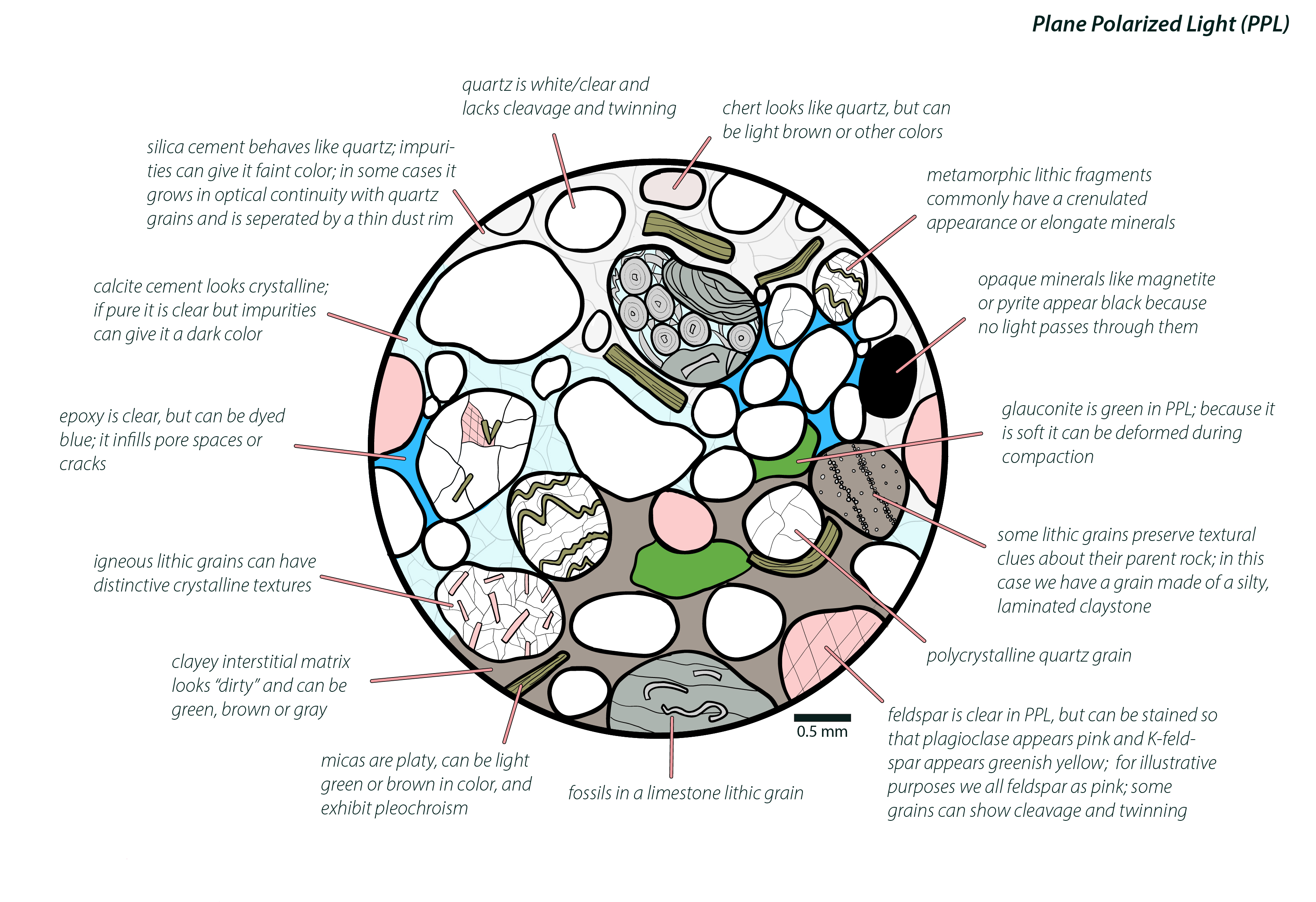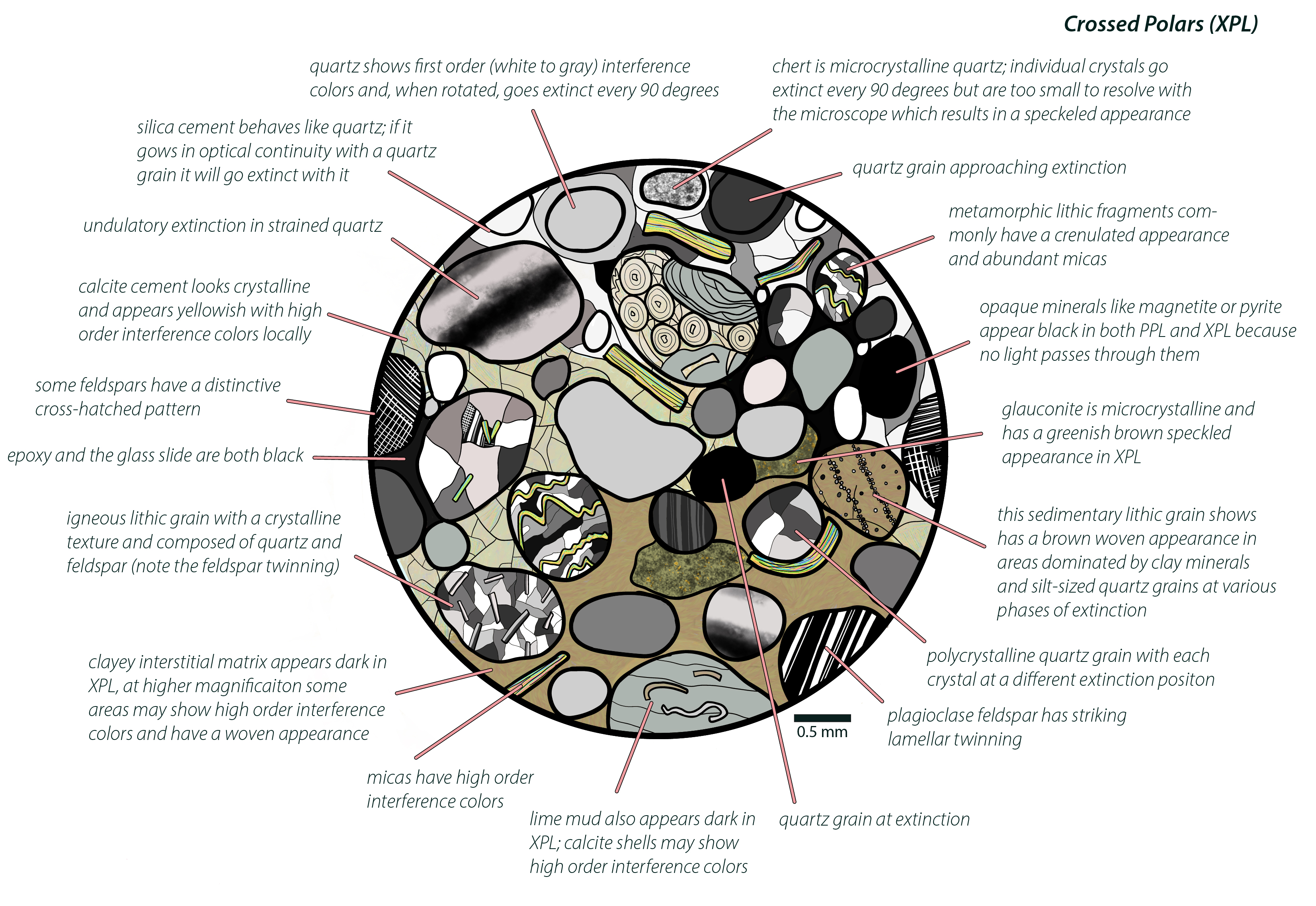5.1: Sandstones
- Page ID
- 26411
Sandstones are clastic sedimentary rocks that are composed largely of sand-sized grains (>50% particles between 1/16 and 2 mm diameter). Sandstones make up approximately 14% of sedimentary rocks and can be found in a wide variety of depositional environments including alluvial fans, rivers and floodplains, beaches, and submarine fans. Porous sandstones can form important reservoirs for water and hydrocarbons; homogenous, well-cemented sandstones are commonly used as building stones.
Composition
Although much information can be gained with a hand lens and an acid bottle, sandstones are best studied in thin section with a petrographic microscope that has polarizing filters. The major components of sandstones include sand-sized framework grains and interstitial areas that originally contained either muddy interstitial matrix and/or open pore space. During diagenesis, mineral cements may precipitate into pore space.
Petrographic Microscopes
If you want a quick refresher on use of the petrographic microscope, a helpful YouTube video is embedded below and several other resources are provided at the bottom of the page.
Video \(\PageIndex{1}\): Review of petrography fundamentals.
Rocks and Minerals in Thin Section
Figure \(\PageIndex{1}\): Summary diagram showing the most common elements of clastic sedimentary rocks in thin section (after Page Quinton via Wikimedia Commons; CC BY-SA 4.0). Note that the same field of view is shown in both, but that the top image shows what the components look like in plane polarized light and the bottom one shows what they look like with crossed polars.
Framework Grains
Framework grains are sand-sized grains that make up the majority of the sandstone. These particles were transported by a moving current and came to rest when turbulence and bedload transport ceased. Grains composed of quartz feldspar, or fragments of other rock are the most common type of sand grains and their relative abundance is used to classify the sandstone; all others are considered accessory minerals.
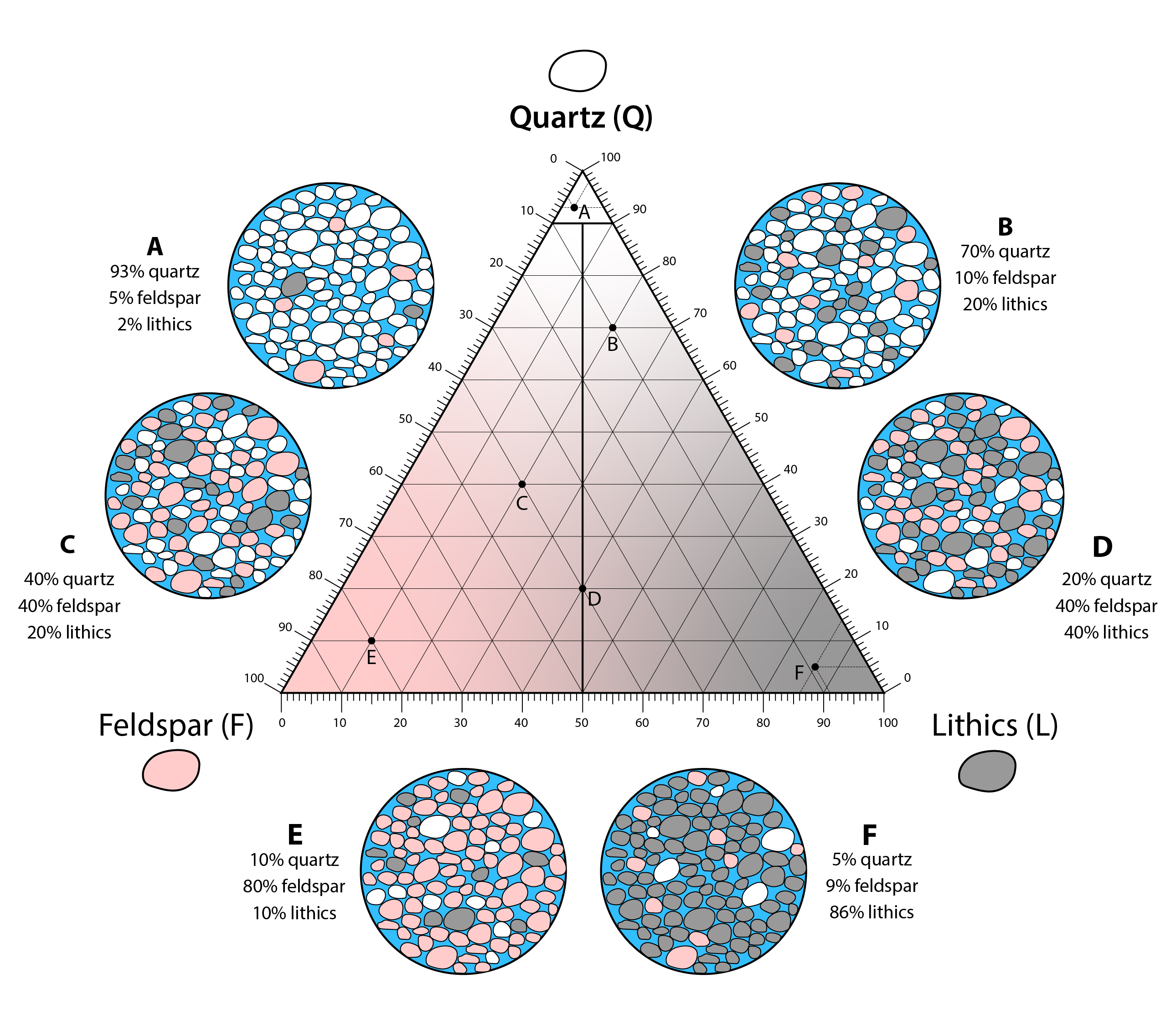
Figure \(\PageIndex{2}\): Ternary diagram showing the relative abundance of quartz, feldspar, and lithics in a sandstone with a few points showing what those abundances would look like (from Michael C. Rygel via Wikimedia Commons; CC BY-SA 4.0).
Quartz
Given its resistance to chemical weathering and abundance in continental crust, quartz is the most common framework grain in most sandstones. In hand sample, quartz grains are easily identified by its glassy appearance and lack of cleavage. In thin section, if the grain is made from a single crystal (monocrystalline) it will appear clear/white in plane polarized light (PPL) and uniformly go extinct every 90° in cross polarized light (XPL). Grains derived from an igneous source may actually be composed of several interlocking crystals (polycrystalline quartz) and those from a metamorphic source may show undulatory extinction. Note that polycrystalline quartz grains (and chert, see lithic grains below) can be counted as quartz if the goal is to focus on compositional maturity. Alternately, polycrystalline quartz and chert can be counted as lithics if the goal is to focus on the composition of the source rocks.
Feldspar
Feldspar grains can be particularly abundant in sandstones derived from granitic source areas and/or in humid climates with limited chemical weathering. Feldspar grains appear clear in PPL and commonly exhibit twinning in XPL. In both cases, cleavage may give the external form and internal planes of weakness a blocky appearance. When making thin sections, it is possible to stain them to help distinguish feldspars from other broadly similar minerals. If stained with cobaltinitrite, potassium feldspar will take on a yellow color; if stained with barium rhodizonate, plagioclase feldspar will turn red.
Lithics
Lithic grains are sand-sized particles of preexisting metamorphic, sedimentary, or igneous rocks. These grains have a variety of appearances, generally they can be composed of multiple minerals, have a complex fabric, and/or have a distinctive composition (ex: carbonate). As discussed above, one could count polycrystalline quartz and chert as lithic fragments if the goal of the analysis was to emphasize source (rather than compositional maturity).
Accessory Minerals
All other sand-sized particles are classified as accessory minerals. Muscovite and biotite micas are common accessory minerals adjacent to many crystalline source areas. The micas are easily identified in hand sample as particularly large, platy grains concentrated along bedding planes; in thin section they appear as large play grains with obvious cleavage and high order birefringence colors in XPL. Magnetite, rutile, tourmaline, zircon, and other resistant minerals may be abundant in some areas.

Figure \(\PageIndex{3}\): Photomicrographs of quartz grains in sandstones; images in plane polarized light are on the left and cross polarized light on the right (all images from Michael C. Rygel via Wikimedia Commons; CC BY-SA 4.0). A & B) Monocrystalline quartz grains. Note that the apparent tight fit of the grains is actually caused by silica cement growing in optical continuity with the grains; in many cases a dust rim shows the grain boundary. C & D) A large polycrystalline quartz granule. E & F) A monocrystalline quartz grain showing undulatory extinction.

Figure \(\PageIndex{4}\): Photomicrographs of feldspar grains; images in plane polarized light are on the left and cross polarized light on the right (all images from Michael C. Rygel via Wikimedia Commons; CC BY-SA 4.0). A & B) Large unstained feldspar grains showing twinning. Scattered quartz grains and abundant interstitial chlorite C & D) Feldspar grains stained yellow for potassium feldspar. The simple grains on the left are single feldspar crystals; the more complex grains on the right are lithic fragments with feldspar in them. E & F) Plagioclase feldspar grains; the bottom half of the image is stained red for plagioclase; the top half of the image is unstained.

Figure \(\PageIndex{5}\): Photomicrographs of lithic grains; images in plane polarized light are on the left and cross polarized light on the right (all images from Michael C. Rygel via Wikimedia Commons; CC BY-SA 4.0). A & B) Lithic grains derived from an igneous rock. C & D) Lithic grains derived from a metamorphic rock - likely a schist or a gneiss. E & F) Lithic granules derived from sedimentary rocks. The large grain near the top right is a fine-grained sandstone; the large grain in the left half of the image is chert.

Figure \(\PageIndex{6a}\): Photomicrographs of accessory minerals, part 1; images in plane polarized light are on the left and cross polarized light on the right (all images from Michael C. Rygel via Wikimedia Commons; CC BY-SA 4.0). A & B) Green glauconite grains and quartz grains from the Flathead Formation (Cambrian), SW Montana. C & D) Large biotite flake surrounded by quartz grains, feldspar grains, and matrix that has been metamorphosed to chlorite. E & F) Muscovite mica (long bladed crystals) with small amounts of quartz.

Figure \(\PageIndex{6b}\): Photomicrographs of accessory minerals, part 2; images in plane polarized light are on the left and cross polarized light on the right (all images from Michael C. Rygel via Wikimedia Commons; CC BY-SA 4.0). A & B) Large dolomite grains and granules in a muddy breccia. C & D) Siderite (probably sphaerosiderite) grains/granules and lithic grains/granules in a lithic sandstone. E & F) Ooids replaced with opaque hematite and surrounded by recrystallized calcite.

Figure \(\PageIndex{6c}\): Photomicrographs of accessory minerals, part 3 - mafic mineral that you might see in igneous rocks; images in plane polarized light are on the left and cross polarized light on the right (all images from Michael C. Rygel via Wikimedia Commons; CC BY-SA 4.0). A & B) In plane-polarized light, hornblende is green to brown, shows pleochrosim, and commonly cleavage. Its shows 2nd to 4th order orange colors under crossed polars C & D) In plane-polarized light, olivine is clear to light green, shows high relief, a lack of cleavage, and fracture. Under crossed polars, it shows a variety of bright 2nd to 3rd order interference colors.
Interstitial Material
Matrix
Matrix is fine-grained, clayey material between the framework grains in some sandstones. Although the origin of matrix is not well understood in all cases, possibilities include deposition of mud in protected areas between grains, deposition as thin layers that are later homogenized, larger particles of flocculated clay, or alteration products derived from unstable grains (pseudomatrix). Regardless of its exact origin, matrix (or its precursor) forms at the time of deposition. Matrix-rich sandstones are commonly dark colored in hand sample; matrix appears as dark, semi-translucent, amorphous material between sand grains in PPL and as dark material with a fine “woven” texture that may have high-order birefringence colors.
Pore space
If not clogged with muddy matrix, the interstitial areas between sand grains are voids filled with water or air. Although sand spherical grains organized into a cubic stacking pattern has a theoretical maximum of 47.6% pore space, actual porosity values of 5-25% are more typical. During the manufacture of thin sections, pore space is commonly filled with epoxy which appears clear or blue (if dyed) in PPL and black in XPL.
Cement
During diagenesis, material dissolved in groundwater commonly precipitate into pore spaces forming mineral cements that bind the sandstone together. The two most common cements in sandstones are silica and calcite. Silica cement commonly nucleates on the surface of quartz grains; in PPL dust rims may delineate the edge of the grains; the silica commonly grows in optical continuity with the grain and may go extinct with it as the microscope stage is rotated in XPL. Although calcite cement appears similar to silica in PPL, it is easily distinguished by high order interference colors in XPL. Beyond these common cements, some sandstones may be cemented with pyrite, hematite, gypsum, kaolinite, illite, or a variety of other minerals.

Figure \(\PageIndex{7}\): Photomicrographs of matrix in sandstones; images in plane polarized light are on the left and cross polarized light on the right (all images from Michael C. Rygel via Wikimedia Commons; CC BY-SA 4.0). A-D) Matrix appears dark in PPL and can have a woven appearance with crossed polars. E & F) Matrix has transformed to chlorite in a sandstone that has experienced low-grade metamorphism.

Figure \(\PageIndex{8}\): Photomicrographs of pore space that was filled with blue epoxy via vacuum impregnation when the thin section was made; images in plane polarized light are on the left and cross polarized light on the right (all images from Michael C. Rygel via Wikimedia Commons; CC BY-SA 4.0).

Figure \(\PageIndex{9}\): Photomicrographs of silica and calcite cement; images in plane polarized light are on the left and cross polarized light on the right (all images from Michael C. Rygel via Wikimedia Commons; CC BY-SA 4.0). A & B) Silica cement that grew in optical continuity with quartz grains; grain boundaries are highlighted by hematite dust rims. C & D) Coarse calcite cement between chert grains. Note the high order birefringence colors. E & F) A quartz arenite sandstone with silica cement predominantly filling interstitial areas on the left and calcite cement largely restricted to the right.
Classification
Older literature and many introductory textbooks recognize three main types of sandstone: quartz sandstone (quartz-rich), arkose (feldspar-rich), and greywacke (muddy sandstone). Although useful when applied to the type of endmember sandstones included in rock and mineral kits, these terms are ambiguous and do not capture much of the variability present in the field.
Dott (1964) proposed a simple two-word naming scheme where the first word (quartz, feldspathic, or lithic) represents the relative abundance of quartz, feldspar, and lithic framework grains and the second word represents the abundance of interstitial matrix (arenite if <10% matrix or wacke if >10% matrix). This scheme allows for a name that speaks to the compositional maturity (framework grain composition) and textural maturity (amount of mud) of the rock.
A few things to consider when classifying sandstones using this scheme include:
- Only quartz, feldspar, and lithic framework grains are used for naming; plotting composition on the ternary diagram requires that their relative abundances be normalized to 100%.
- Cement is a diagenetic feature and not used to name sandstones.
- The amount of matrix is estimated for the entire volume of the rock. This represents the entire field of view in thin section. In hand sample, wackes are distinguished by the presence of dark, fine-grained material rather than glassy or shiny cement.
- Although proper classification requires point counting of ~300 sand grains in thin section, quick visual estimation using a hand lens or thin section usually produces satisfactory results.
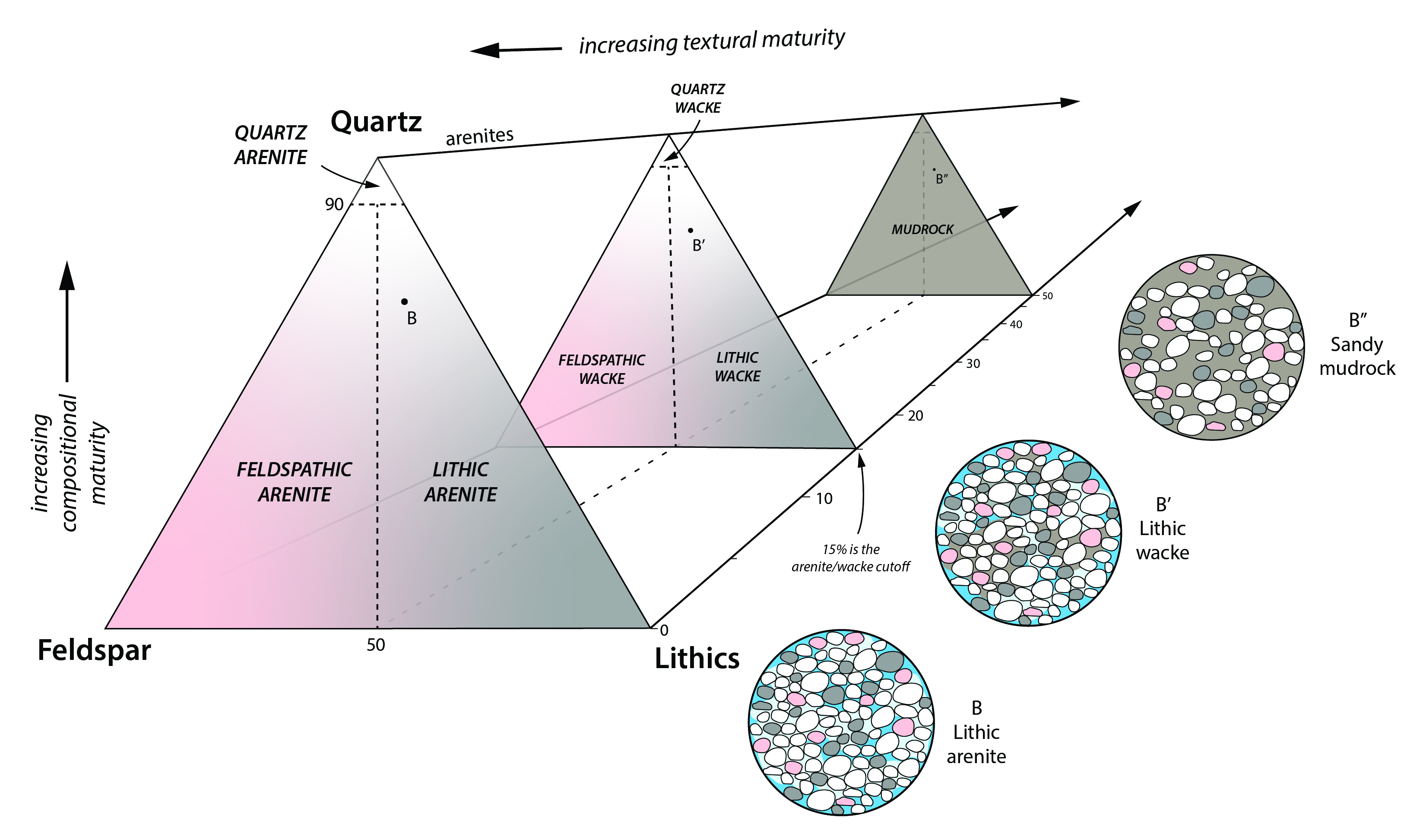
Figure \(\PageIndex{10}\): A three dimensional diagram for the classification of sandstones. The triangle is a ternary diagram showing the relative abundance of quartz, feldspar, and lithics. The third dimensions shows the relative amount of interstitial matrix (from Michael C. Rygel via Wikimedia Commons; CC BY-SA 4.0). Modified from Dott (1964).
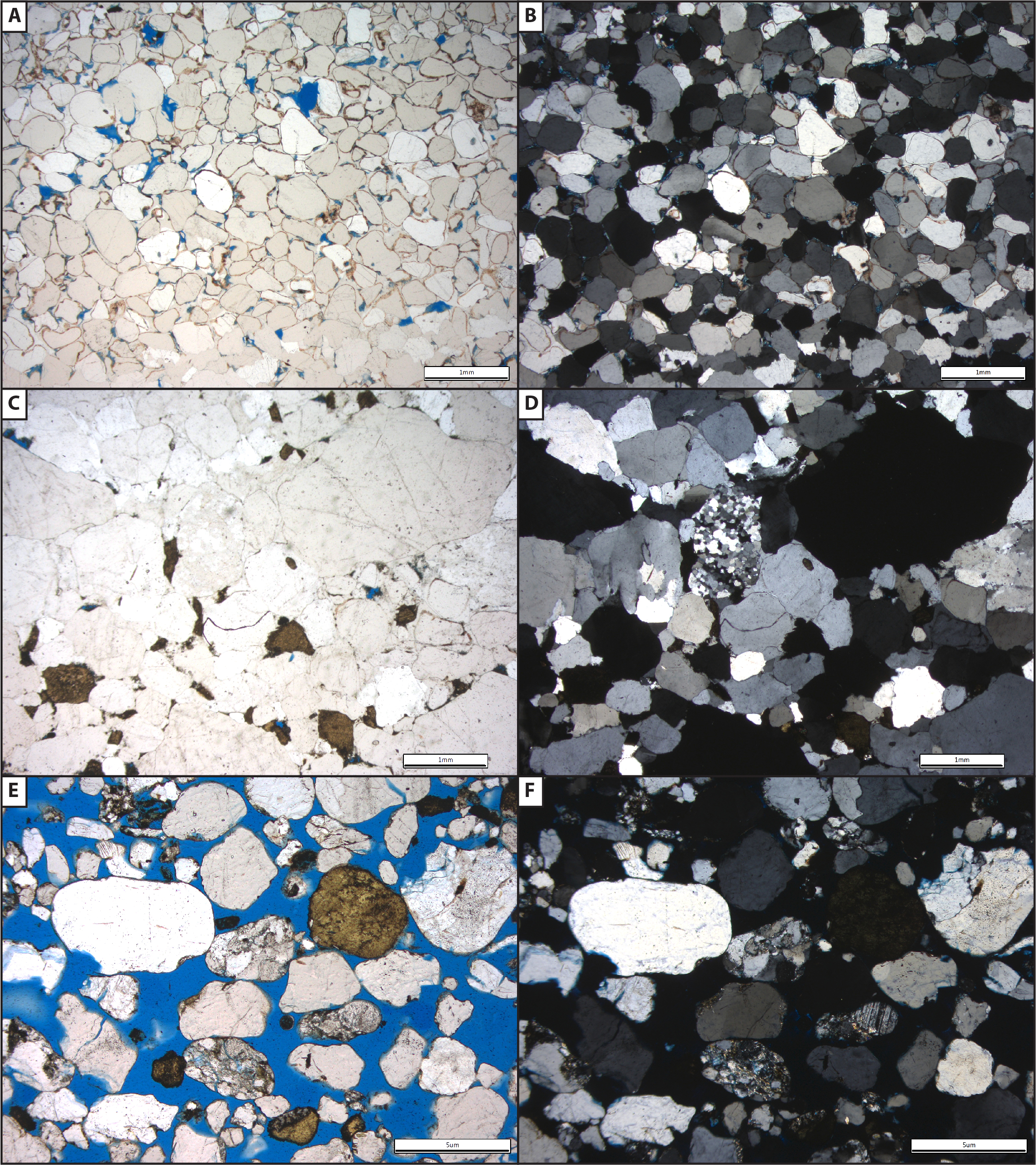
Figure \(\PageIndex{11}\): Photomicrographs of arenite sandstones with little/no matrix; silica and calcite cement; images in plane polarized light are on the left and cross polarized light on the right (all images from Michael C. Rygel via Wikimedia Commons; CC BY-SA 4.0). A & B) show a quartz arenite with silica cement and modest amounts of pore space. C & D) show a silica-cemented feldspathic arenite; note that this slide was stained for potassium feldspar. E & F) show a poorly cemented and friable lithic arenite.

Figure \(\PageIndex{12}\): Photomicrographs of wacke sandstones with significant amounts of matrix; images in plane polarized light are on the left and cross polarized light on the right (all images from Michael C. Rygel via Wikimedia Commons; CC BY-SA 4.0). A & B) show a quartz wacke with a modest number of lithic grains. C & D) show a lithic wacke with mainly igneous lithic grains, E & F) show a feldspathic wacke with matrix that has been transformed to chlorite.
Additional Resources and Readings
- Introduction to Petrology OER textbook with great explanations and videos about thin sections and the petrographic microscope - https://viva.pressbooks.pub/petrology/front-matter/table-of-content/
- Short video about stains for feldspars and carbonate minerals: https://www.youtube.com/watch?v=qIGWga1ElKE
- Discussion about provenance, plate tectonics, and what to do with polycrystalline quartz and chert: https://www.geological-digressions.com/provenance-and-plate-tectonics
- Dott, R.H., 1964, Wacke, Graywacke and Matrix - What Approach to Immature Sandstone Classification?, Journal of Sedimentary Petrology, v. 34, p. 625-632


